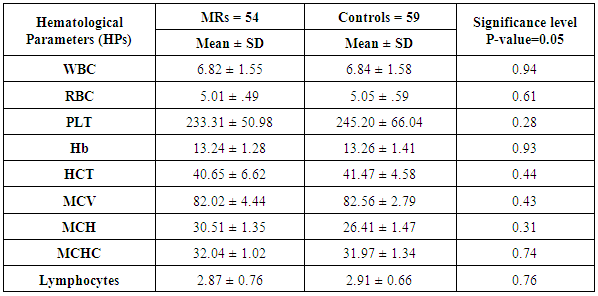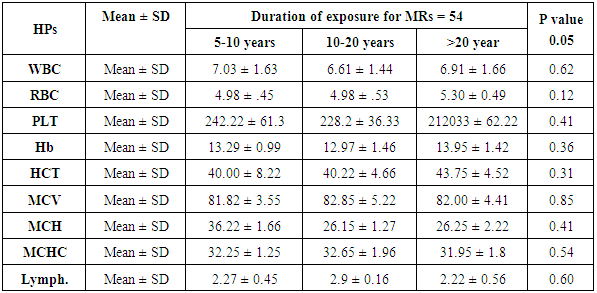-
Paper Information
- Next Paper
- Previous Paper
- Paper Submission
-
Journal Information
- About This Journal
- Editorial Board
- Current Issue
- Archive
- Author Guidelines
- Contact Us
American Journal of Medicine and Medical Sciences
p-ISSN: 2165-901X e-ISSN: 2165-9036
2017; 7(6): 238-241
doi:10.5923/j.ajmms.20170706.02

Assessment of Hematological Parameters among Medical Radiographers at Governmental Hospitals, Gaza Strip
Mousa Alnahhal1, Yasser Alajeramy2, Safaa Abu Mostafa2, Khalid Abu Shab3, Sadi Jaber2, 3, Ahmad Najim4
1Department of Magnetic Resonance, Gaza-European Hospital, Gaza Strip, Palestine
2Department of Medical Imaging, Applied Medical Sciences, Al-Azhar University, Palestine
3Department of Neonatal Intensive Care Unit, Nasser Hospital, Gaza Strip, Palestine
4Department of Nursing, Applied Medical Sciences, Al-Azhar University, Palestine
Correspondence to: Mousa Alnahhal, Department of Magnetic Resonance, Gaza-European Hospital, Gaza Strip, Palestine.
| Email: |  |
Copyright © 2017 Scientific & Academic Publishing. All Rights Reserved.
This work is licensed under the Creative Commons Attribution International License (CC BY).
http://creativecommons.org/licenses/by/4.0/

Background: Medical radiographers are known to be exposed to long term and chronic low doses of ionizing radiation. The biological effects of chronic low-doses radiation on human health are complex and have not been well established. Objective: To assess the effects of ionizing radiation on the hematological parameters of medical radiographers at governmental hospitals-Gaza Governorates, Palestine. Materials and Methods: The study was conducted at the six main governmental hospitals. A total of 54 healthy medical radiographers with at least 5 years of experience were compared with 59 healthy participants as control group. The study group matched with controls in age, gender, years of experience, and smoking status. Hematological parameters were observed by ABX Micros 60 analyzer. The statistical analysis was done by using Student’s t test and one way ANOVA test. Results: The study reported that the basic hematological parameters including the mean value of red blood cells (P=0.611), white blood cells (P=0.942), and platelets level (P=0.28) did not show any statistical significant differences between the compared groups. Low and high disturbance in the mean values of hematocrit and corpuscular hemoglobin in some medical radiographers, but their means did not reach the statistical significant levels. No statistical significant differences was found between the duration of exposure and hematological parameters of medical radiographers. Conclusion: It concluded that in addition to the safety and protective measures that have adopted in different radiology departments, we recommended using appropriate personal protective measures for medical radiographers (i.e., periodic medical surveillance including the hematological parameters). Furthermore, performing a research projects on radiation protection and hazards to prevent irreversible damages.
Keywords: Hematological parameters, Medical radiographers, Ionizing radiation, X-ray
Cite this paper: Mousa Alnahhal, Yasser Alajeramy, Safaa Abu Mostafa, Khalid Abu Shab, Sadi Jaber, Ahmad Najim, Assessment of Hematological Parameters among Medical Radiographers at Governmental Hospitals, Gaza Strip, American Journal of Medicine and Medical Sciences, Vol. 7 No. 6, 2017, pp. 238-241. doi: 10.5923/j.ajmms.20170706.02.
Article Outline
1. Introduction
- X-ray is a form of ionizing radiations that produced by shooting accelerated electrons at a heavy metal target. These ionizing radiations penetrate the living tissues and can destroy living cells or make them functionally abnormal [1]. Consequentially, expected damage in the molecular structure as a result of ell dysfunction (somatic effect) or mutations (genetic damage) [2].Medical Radiographers (MRs) who occupationally exposed to chronic low doses ionizing radiation are prone to develop life-threatening diseases especially related to hematopoietic system. In addition, hematopoietic system is highly sensitive to radiation and the peripheral blood examination may serve as a biological I ndicator of such damage [3].Over the last decades, there was a trend to investigate the biological effects of the radiation using hematological, biochemical, and cytogenetic parameters [4]. These investigations have reported that stochastic effects may appear after the exposure to low level of ionizing radiation [5]. Deterministic effects are well-known and often need higher radiation doses than received by MRs [6]. Therefore, the concern and unawareness of MRs are related to the stochastic effects of long-term exposure to low-dose radiation. The risk of stochastic effects such as cancer increase by dose without threshold [7].Peripheral blood examination may serve as a screening test for various hematological as well as non-hematological disease states. Being a simple, inexpensive, point-of-care test, the blood cell count (CBC) is especially valuable for diagnostic purposes in the subclinical stage of many diseases. In addition, blood cell examination allows the clinicians to achieve broad differential diagnostic impressions [8]. This study aims to identify the effects of ionizing radiation on the hematological parameters of MRs at governmental hospitals, Gaza governorates, Palestine.
2. Materials and Methods
- Sampling process: The current study was conducted in the six main governmental hospitals between April and November 2015. A total of 54 (40 males and 14 females) MRs with age between 28-55 years old were occupationally exposed to long term low doses of ionizing radiation and having at least 5 years' experience in radiology. The selected cases were compared with another group of 59 (44 males and 15 females) healthy participants who never exposed to radiation as a control group. The exposed group was matched with controls in age, gender, years of experience, and smoking status. MRs were worked on different types of imaging modalities and equipments including conventional and computed radiography, computed tomography (CT), and magnetic resonance imaging (MRI). Also they worked in different shifts for 7 hours a day for five days per week.Exclusion Criteria: Participants who had any previous diseases such as gross anemia, known history of diabetes mellitus, cardiopulmonary disease, acute or chronic infection, autoimmune disease, and malignancy were excluded from the study. Also, participants with less than 5 years employment were excluded from the study. Hematological analysis: Blood samples of all participants were collected (2 ml of blood from each participants) by vein-puncture in a disposable syringe and blood was transferred to a tube containing ethylene diamine tetra acetic acid (EDTA) in a concentration of 1.5mg/ml. Hematological parameters (HPs) were measured by using s ABX Micros 60 analyzer at private and standard laboratory. Nine of the HPs were examined in this study including red blood cells (RBC), white blood cells (WBC), platelet count (PLT), hematocrit (HCT), hemoglobin (Hb), and mean corpuscular hemoglobin (MCH), mean corpuscular hemoglobin concentration (MCHC), mean corpuscular volume (MCV), and a typical lymphocytes. Blood samples were collected from all participants after obtaining an ethical approval from Helsinki committee.Statistical analysis: All statistics were performed in SPSS version 20 software. The means of quantitative variables were compared using both independent sample t-test and one- way ANOVA. A significant P-value was considered when it is less than 0.05.
3. Results
- The present study was focused on the hematological parameters (HPs) of medical radiographers (MRs) through cell blood count (CBC). Fifty four participants (40 males and 14 females) of MRs were included in this study as exposed group and nine HPs were examined to assess the effects of ionizing radiation. The mean age for MRs was 35.39 ± 6.38 years, while it was 37.05 ± 6.85 years for the control group. As shown in table (1), no statistically significant differences between MRs and the control group in all listed hematological parameters. It should be noted that there were four MRs participants found with lower levels of hematocrit and also 3 have higher values of corpuscular hemoglobin.
|
|
|
4. Discussion
- Long term exposure to low doses of ionizing radiation may affect adversely on cells and tissues. Hematopoietic system is known to be radiosensitive and can be affected by chronic exposure to low dose of ionizing radiation resulting in peripheral blood cells count. The present study is the first study conducted in Gaza Strip, Palestine. Thus, this study has recruited medical radiographers as they are continuously exposed to occupational ionizing radiation typically x-ray. The present study incorporated nine hematological parameters (HPs) for MRs compared with matched control group. The aim was to assess the effects on hematological parameters in medical radiographers exposed to radiation due to occupation.Blood cell count (CBC) analysis is a useful screening test in routine medical check-up. A high or low blood cells count even in a healthy-looking subject lead to the suspicion of disease and it should prompt further investigations. Some studies have demonstrated the negative effect of low doses radiation on hematological parameters while others detect the change at genetic analysis level only.The current study results showed that the mean differences of the basic hematological parameters including WBC, RBC, and, PLT in MRs did not reach the statistically significant levels when compared with controls. Our results were approved to several recent studies conducted in Iran, Iraq, Egypt, and Sudan which reported some variations in the basic HPs with no statistically significant [9-15]. However, recent studies conducted in Poland and Pakistan, Sudan, Sudia Arabia Kingdom found statistically significant difference between exposed and non-exposed subjects regarding to lymphocytes count [16-19]. These results and variations can be attributed to the performing and practices of protection standards and experience years among exposed participants. The other HPs especially HCT and Hb found low and high in some medical radiographers but not reach the statistically significant levels. These results were matched with studies of Shaffie, 2016 and Korrami, 2015 [9, 13]. Moreover, the HPs did not reach the statistically significant levels when they compared with the duration of work of MRs. Our findings were consistent to the study conducted in Iraq, they found no statistically significant differences between HPs and duration of work for exposed X–ray workers [13].
5. Conclusions and Recommendations
- Based on the current results, restrict auditing on personal protective tools for MRs is highly recommended. Additionally, to that protection and safety applied, and should undergo periodic medical surveillance including hematological parameters. These measures will help to decrease the effects of occupational hazards of radiation and detect the disease in initial stage.
 Abstract
Abstract Reference
Reference Full-Text PDF
Full-Text PDF Full-text HTML
Full-text HTML

